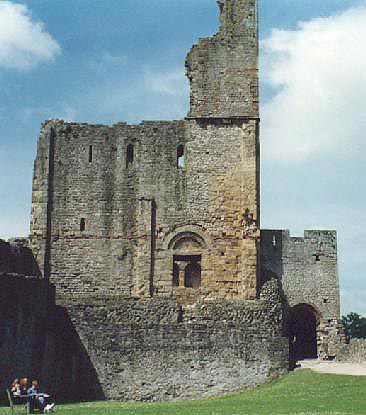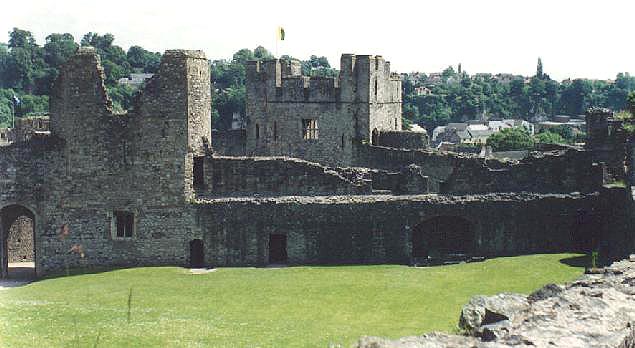Chepstow Castle
If there is a castle that comes close to matching Harlech in historical importance, that castle is surely Chepstow. Chepstow is perched high above the banks of the river Wye in southeast Wales. Construction began at Chepstow in 1067, less than a year after William the Conqueror was crowned King of England. While Edward had his master castle builder in the person of James of St. George, William the Conqueror, some 200 years earlier, had his equal in the person of his loyal Norman lord, FitzOsbern. FitzOsbern's fortresses were the vehicles from which the new king consolidated control of his newly conquered lands. Chepstow Castle became the key launching point for expeditions into Wales, expeditions that eventually subdued the rebellious population. Chepstow's Great Hall begun in 1067, is the oldest surviving stone fortification in Britain. Because of this, the site has a special significance to British history. At other
castles built during the Conqueror's reign, original Norman structures have long since disappeared, but at Chepstow it's still possible to see and touch the remains of FitzOsbern's
first great building project in Wales. The Normans weren't the first to recognize the strategic position of Chepstow. The arch above the main doorway to the hall is made from brick brought from a Roman fort that once stood nearby. The hall was always the heart of the castle, and originally stood alone. Over the years, the castle was enlarged by a series of builders. Today, the castle takes the shape of a long rectangle perched high above the river Wye. Inside the hall, powerful men mapped out strategy with other Welsh "Marcher
Lords," planning invasions to wrest control of Wales from groups of powerful princes still holding most of the country. Besides William FitzOsbern, earl of Hereford, Chepstow's other famous lords include William Marshall, earl of Pembroke, and Roger Bigod, earl of Norfolk. Depending on your perspective, these are some of the most important or hated men of Norman-Welsh history. The Great Hall and dramatic cliff-side at Chepstow are the castle's two most interesting features. The rest of the castle is a typical Norman structure - a large gatehouse with high curtain walls connecting a series of tall towers. Because Chepstow was built in stages along the river Wye, the castle is constructed in a long, terraced fashion as opposed to a concentric layout. This unique construction is another reason the castle is so memorable. Chepstow's strategic position allowed defenders to supply the castle via the river during times of battle and siege, while defending it against attack. Because of its history, the Great Hall evokes a kind of respect not shared by other Welsh castles.
Chepstow's Great Hall begun in 1067, is the oldest surviving stone fortification in Britain. Because of this, the site has a special significance to British history. At other
castles built during the Conqueror's reign, original Norman structures have long since disappeared, but at Chepstow it's still possible to see and touch the remains of FitzOsbern's
first great building project in Wales. The Normans weren't the first to recognize the strategic position of Chepstow. The arch above the main doorway to the hall is made from brick brought from a Roman fort that once stood nearby. The hall was always the heart of the castle, and originally stood alone. Over the years, the castle was enlarged by a series of builders. Today, the castle takes the shape of a long rectangle perched high above the river Wye. Inside the hall, powerful men mapped out strategy with other Welsh "Marcher
Lords," planning invasions to wrest control of Wales from groups of powerful princes still holding most of the country. Besides William FitzOsbern, earl of Hereford, Chepstow's other famous lords include William Marshall, earl of Pembroke, and Roger Bigod, earl of Norfolk. Depending on your perspective, these are some of the most important or hated men of Norman-Welsh history. The Great Hall and dramatic cliff-side at Chepstow are the castle's two most interesting features. The rest of the castle is a typical Norman structure - a large gatehouse with high curtain walls connecting a series of tall towers. Because Chepstow was built in stages along the river Wye, the castle is constructed in a long, terraced fashion as opposed to a concentric layout. This unique construction is another reason the castle is so memorable. Chepstow's strategic position allowed defenders to supply the castle via the river during times of battle and siege, while defending it against attack. Because of its history, the Great Hall evokes a kind of respect not shared by other Welsh castles.Superbly set high upon its river cliff above the Wye, Chepstow still guards one of the main river crossings from southern England into Wales. Few castles in Britain tell the story of medieval fortification, from beginning to end, as does this mighty stronghold. It was probably the very first stone castle in the entire country, and was to see successive developments right through to the Civil War of the 17th century. Throughout the Middle Ages, Chepstow was the center of military and administrative power in the Marcher lordship of Strigoil. Within a few months of the Battle of Hastings, Lord of Breteuil in Normandy was created Earl of Hereford by William the Conqueror, and was given the task of subduing the southern Welsh borderlands. Before his death in 1071 he had built the rectangular keep, which still forms the core of the castle today. It is the earliest dateable secular stone building in Britain, but is very similar to other 11th-century hall-keeps in Normandy. Notice that the builders used several bands of red Roman tile in the construction, probably robbed from the ruins of Caerwent. The small round-headed windows in the ground floor are also original features. At the end of the 12th century, Chepstow passed by marriage to a formidable soldier of fortune, and earl of Pembroke. With considerable experience in military architecture in France, he set about bringing fitz Osbern's castle up to date. He rebuilt the east curtain wall, with two round towers projecting outwards, in order to protect this vulnerable side. Arrow-slits in the towers were designed to give covering fire to the ground in front of the curtain, and this was one of the earliest examples of the new defensive mode which was to become characteristic of the medieval castle. Before 1245, the sons of William Marshall greatly enlarged Chepstow's defences and improved the internal accommodation. They added a new lower bailey, with an impressive twin-towered gatehouse. At the upper end of the castle, a strongly defended barbican was constructed at this time. Marshall's sons also made additions to the Great Tower, or keep.

Between 1270-1300 Roger Bigod III, one of the greatest magnets of his day, built a splendid new hall block on the north side of the lower bailey. The range included a large, vaulted cellar, elaborate service rooms, a kitchen, domestic accommodation and, of course, the hall itself. There is also a latrine set spectacularly high over the river cliff, across the bailey, away from the noise of the hall and the kitchen smells. Bigod built a huge new tower on the south-east corner. This was to provide a suite of accommodation worthy of a nobleman of high rank. As well as the domestic apartments, Marten's Tower also included a private chapel, with richly carved decoration and a seat at either side for the priest. Unusually, when raised, the portcullis closing off the wall-walk below would have stood in front of the alter. Roger Bigod was also responsible for the construction of the splendid 'Port' or town wall which still survives along much of its length. Chepstow was further modified in the Tudor period, and in the Civil War it was twice besieged. Its defences, designed against medieval attack, fell both times to Parliamentary cannon. Following the war, the whole southern face of the castle was reinforced with earth and stone as a prevention against further cannon fire. The parapets were remodeled with musket loops.Chepstow was also used for State prisoners at this time, and the republican and regicide Henry Marten, spent 20 years of fairly comfortable captivity in the tower which now bears his name.